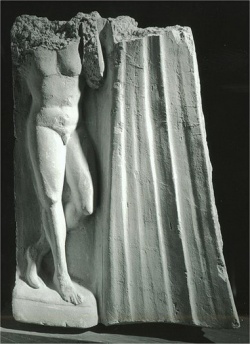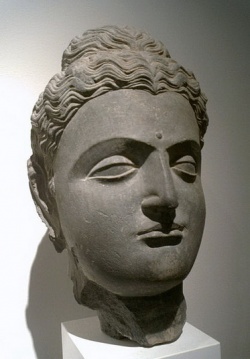After Alexander
Alexander conquered the Indus valley and returned to the west, where he died on 11 June 323. His kingdom was divided between his generals; Gandara and the other eastern provinces were given to Seleucus, the first king of the Seleucid empire. But his position was threatened in the west and he needed an army to defend himself; therefore, in 304, he conducted negotiations with to the Indian king Chandragupta (321-297), whose capital was Patna on the Ganges (304). Seleucus gave up the eastern satrapies, and in return received a great number of Elephants - five hundred, according to the ancient tradition - which made him invincible on the western front.
The two rocks at Shahbazgarhi. Photo Marco Prins.
Ashoka's rock edicts near Shahbazgarhi
From now on, Gandara was part of the Indian empire that is known as that of the Mauryan kings. But Gandara remained open to Greek influences and the successors of Chandragupta and Seleucus continued to exchange ambassadors. The Mauryan king Ashoka (272-232), who conquered almost the entire subcontinent and converted to Buddhism, announced his rock edicts not only in Indian, but also in Greek - at least in Gandara and Arachosia, which suggests that there was still a strong presence of Yavanas (Greeks).
After 240, the Bactrian leaders, who were of Greek descent, revolted from their Seleucid overlords, but king Antiochus III the Great restored order (206). Soon after, however, Antiochus was defeated by the Romans, and the Bactrian leader Euthydemus declared himself independent. Not much later, the Graeco-Bactrian kingdom expanded into Drangiana, Gandara and the Punjab, where Mauryan Power was now in decline.
King Menander (©!!)
This invasion, which took place in 184, revitalized the Greek culture in the region south of the Hindu Kush, where Euthydemus' son Demetrius created a new kingdom, consisting of Gandara, Arachosia, the Punjab and a part of the Ganges valley (Delhi). It was a multi-ethnic society, in which Greeks, Bactrians, western Iranians and Indians lived together. Greek religious practices, Iranian cults, Hinduism and Buddhism are all known from second-century Gandara. Coins were modeled on the drachmas of Athens, although they often had Indian legends. The city of Taxila was rebuilt as a Greek town (like a gridiron).
Demetrius' rule lasted from c.184 to c.170; on his Death, his kingdom was divided by his sons Euthydemus, Demetrius, Pantaleon and Agathocles.
King Menander (c.125) reunited the Indo-Greek kingdom and even invaded the heartland of the contracted Mauryan empire, where he captured Patna. Menander is known from Indian sources as Minedra; one of the holy texts of Buddhism is called Milindapañha, "Questions of Menander".
Gandaran coin showing Buddha. Drawing Bente Kiilerich. From Acta Hyperborea 1 (1988). Buddha on a Kushan coin.Greek legend: Boddo. Drawing Bente Kiilerich (©*)
However, the end of the Greek renaissance in Gandara was near. After Menander's Death, his kingdom fell apart in at least forty petty kingdoms (their existence is known from coins). Before the end of the second century, several had been taken over by the Sacae.
This is the usual name for the nomad tribes of Central Asia, who always tried to invade the territories to their south, such as Bactria. They had been kept away since the age of king Cyrus, but had ravaged the Graeco-Bactrian kingdom in c.130 and had finally settled in Drangiana, which was henceforth called Sacastane or Sistan, its modern name. After 110, they launched raids on Gandara and infiltrated in the southern Indus valley.
At the same time, the Parthians became interested in the region and started to take over the Greek petty kingdoms in Gandara. One of the Parthian leaders, living in Taxila, was named Gondophares; according to an old and wide-spread Christian tradition, he was baptized by the apostle Thomas. The story is not impossible: as we already noted, adherents of several religions lived together in Gandara and the Punjab, and there may have been an audience for a representative of a new Jewish sect.
The Sacae and Parthians were still fighting for the possession of the remaining petty kingdoms, when the Yuezhi nomads (or Kushans) invaded. They were able to reunite the region, although it is not exactly clear when this happened. (The famous king Kanishka is possibly to be dated 127-170.) From their capital Peshawar in Gandara, the new kings ruled a powerful Buddhist empire, in which the Indian, Iranian, Sacan, Parthian and Greek elements were integrated.
It may be interesting to note that they were the first to make statues of Buddha, who was dressed in an Indian coat but standing like a Greek God. These statues were first made in Gandara. The most famous examples were those in the Bamyan valley (technically not in Gandara but Bactria), which were destroyed by the Taliban in the spring of 2001.

